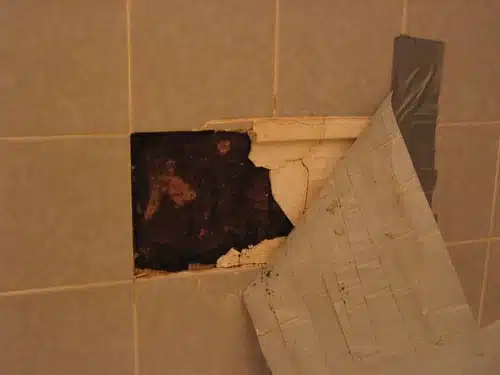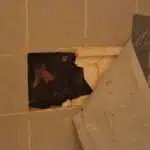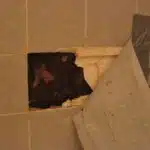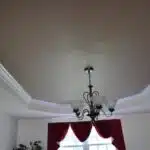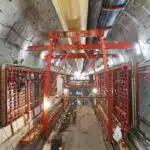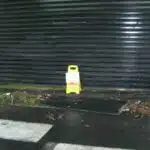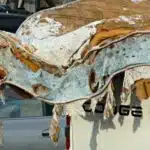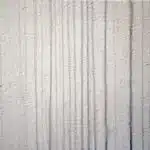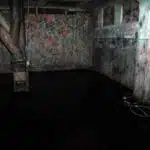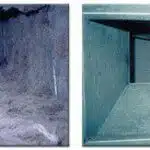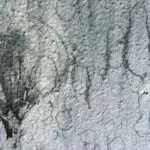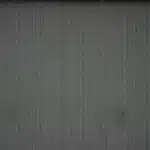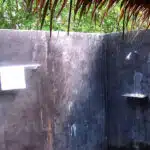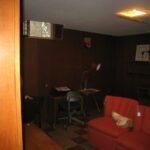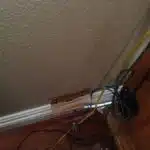Mold is a type of fungus that thrives in damp and humid environments, especially inside buildings. When mold grows inside walls, it can cause structural damage and pose a health hazard to occupants. Removing mold from inside walls is a complex process that requires specialized knowledge, equipment, and techniques.
As a mold remediation specialist, I have seen the devastating effects of mold on homes and businesses. From discoloration to respiratory problems, mold can take a toll on the well-being of occupants. In this article, I will provide guidance on how to remove mold from inside walls safely and effectively. Whether you are a homeowner or a property manager, this information will help you serve your community by creating safer and healthier living spaces.
Identifying Mold Growth
As a mold remediation specialist, it is crucial to understand the importance of identifying mold growth. Mold can thrive in damp and humid environments, especially on porous surfaces such as drywall and insulation. A mold inspection involves a thorough examination of the affected areas to determine the extent of the damage.
Prevention techniques are vital in avoiding mold growth inside walls. Homeowners should be aware of any water leaks, condensation, or high humidity levels that may contribute to mold growth. Proper ventilation is also essential as it helps in regulating moisture levels in the house. Regular cleaning and maintenance of HVAC systems can prevent mold from spreading through air ducts.
Mold growth inside walls poses significant health risks to occupants. Exposure to mold spores can cause allergic reactions, respiratory problems, and other health issues. It is essential to understand these risks and take immediate action when signs of mold growth are noticed. The subsequent section will discuss these health risks in detail and provide insights into how best to manage them.
Understanding The Health Risks Of Mold
Mold allergies are quite common and can cause numerous symptoms ranging from mild to severe. These symptoms include coughing, sneezing, runny nose, itchy eyes, and skin irritation. Some people may also experience more serious health effects such as difficulty breathing or asthma attacks. If you suspect that you have mold inside your walls, it’s crucial to understand the potential health risks associated with prolonged exposure.
Prolonged exposure to mold can have serious consequences on your overall health. Mold spores can worsen existing respiratory conditions such as asthma and allergies. Additionally, long-term exposure to high levels of mold can lead to neurological problems and even cancer. It’s essential to take mold growth seriously and address it promptly to ensure the safety of your home.
It’s important to note that not everyone will experience health problems due to mold exposure. However, if you’re experiencing any symptoms or have concerns about the presence of mold in your home, it’s best to consult a professional for advice on how to proceed. In the next section, we’ll discuss how you can prepare for mold removal and ensure that the process is carried out safely and effectively.
Preparing For Mold Removal
Gathering supplies for mold removal requires the appropriate protective equipment, such as respirators, protective eyewear, and full body suits. In addition, a number of cleaning and disinfecting agents may be necessary, such as chlorine bleach and detergents.
Prior to commencing any mold removal, the room must be properly prepared. This includes covering any furniture and removing any items that are not necessary for the remediation process. Additionally, the area should be well-ventilated, and any fans or dehumidifiers should be set up in the room.
Gathering Supplies
As a mold remediation specialist, the first step in preparing for mold removal is gathering supplies. It’s important to have all the necessary tools and products before beginning the process. Where to buy these supplies will depend on your location and preference. Many hardware stores carry mold removal products such as bleach, vinegar, and hydrogen peroxide. Online retailers such as Amazon also offer a wide variety of options.
In addition to traditional mold removal products, some individuals may prefer DIY alternatives. These can include natural remedies such as tea tree oil or baking soda. It’s important to note that while these may be effective, they should not replace professional mold remediation services if the problem is severe.
Ultimately, regardless of where you choose to purchase your supplies or what method you use, it’s crucial to have everything on hand before starting the mold removal process. This will ensure that the job can be completed efficiently and effectively with minimal interruption to daily life.
Preparing The Room
As a mold remediation specialist, the process of preparing for mold removal involves several crucial steps. Once you have gathered all the necessary supplies, the next step is to prepare the room itself. This involves taking certain precautions to ensure that the mold does not spread further during the removal process.
One important aspect of preparing the room is ensuring proper ventilation. Mold spores can quickly spread through the air, and it’s vital to prevent this from happening during removal. Open windows and doors where possible, and use fans to circulate air throughout the space. This will help to prevent spores from settling on other surfaces and causing further contamination.
Another key consideration when preparing for mold removal is surface cleaning. All surfaces in and around the affected area should be thoroughly cleaned before beginning any removal work. Use a damp cloth or sponge with soap and water to clean walls, floors, and furniture. This will help to remove any visible mold growth before applying any products or treatments for more thorough remediation. By taking these steps in advance, you’ll be better prepared for effective mold removal with minimal disruption to your daily life.
Gathering The Necessary Equipment And Supplies
Gathering the Necessary Equipment and Supplies is a crucial step when it comes to removing mold from inside walls. The right selection of equipment can make the process easier and more efficient. It is essential to have all the necessary tools and supplies before starting the remediation process. This will save you time, money, and effort.
Equipment selection is critical for a successful mold remediation process. Depending on the extent of mold growth, you may need to invest in specialized equipment such as air purifiers, HEPA vacuums, dehumidifiers, and protective gear like gloves, masks, goggles, etc. When selecting your tools and supplies, ensure that they are appropriate for the job at hand. Using substandard equipment or supplies can lead to ineffective remediation or even pose a safety hazard.
Safety precautions should be taken seriously when dealing with mold remediation. Mold spores can cause adverse health effects if inhaled or come into contact with your skin. Therefore, it’s essential to wear protective gear such as gloves, masks, goggles while handling moldy materials or using chemicals during remediation. Proper ventilation is also critical during this process to prevent exposure to harmful fumes or gases that may be released from cleaning agents or other materials during remediation. Always read labels carefully before use and follow instructions strictly.
Transitioning into setting up containment measures: Now that you have gathered all the necessary equipment and supplies and taken safety precautions into consideration let’s move onto setting up containment measures. Containment measures are critical in preventing cross-contamination of mold spores to other areas within your home or building during remediation. These measures include creating negative air pressure within the work area by sealing off doors and windows using plastic sheeting along with airlocks between contaminated areas with uncontaminated ones.
Setting Up Containment Measures
Containment measures are crucial when removing mold from inside walls. These measures are necessary to prevent the spread of mold spores throughout the home, which can cause health problems and further damage to the property. Containment measures usually involve sealing off the affected area and creating negative pressure to ensure that mold spores do not escape into other parts of the building.
To set up containment measures, you will need to use heavy-duty plastic sheeting and duct tape to seal off any openings, including doors and windows. It is essential to cover all vents, ducts, and other openings that may allow air or moisture to escape. Once you have sealed off the area, you can use an air scrubber or negative air machine to create negative pressure inside the containment area. This machine pulls air from outside of the containment area into a filter system before exhausting it outdoors.
Safety precautions are also critical when setting up containment measures for mold removal. You should wear protective gear such as gloves, goggles, and a respirator mask when handling moldy materials or working in a contaminated area. It is also important to follow proper disposal procedures for any materials that come into contact with mold spores.
- Use heavy-duty plastic sheeting and duct tape to seal off any openings
- Cover all vents, ducts, and other openings that may allow air or moisture to escape.
- Wear protective gear such as gloves, goggles, and a respirator mask.
As we move on to wearing protective gear while removing mold from inside walls, it is essential to note that this step goes hand in hand with setting up containment measures. The goal is not only to prevent contamination but also protect yourself from harmful exposure. Mold remediation specialists understand how critical it is not only for them but also their clients’ safety that they follow these precautions meticulously.
Wearing Protective Gear
After setting up containment measures, the next step in mold remediation is selecting appropriate gear and taking safety precautions during removal. According to a study by the National Institute for Occupational Safety and Health, exposure to mold can cause respiratory problems and other health issues. This makes it crucial to take the necessary precautions to protect yourself during the removal process.
Selecting appropriate gear is essential when removing mold from inside walls. It is recommended that you wear a respirator with a HEPA filter to prevent inhalation of mold spores. Additionally, you should wear gloves, eye protection, and disposable coveralls to protect your skin from contact with mold.
Taking safety precautions during mold removal is also critical. Before starting the removal process, turn off the HVAC system to prevent spreading mold spores throughout your home. It is also recommended that you wet the affected area with water before starting removal to prevent spores from becoming airborne. Finally, seal off the area being worked on using plastic sheeting and duct tape.
In summary, selecting appropriate gear and taking safety precautions during mold removal are crucial steps in ensuring a safe and successful remediation process. In the next section, we will discuss removing damaged materials from inside walls affected by mold growth.
Removing Damaged Materials
Assessing damage is the first step in removing mold from inside walls. The extent of the damage will determine what materials need to be removed. If the mold has only affected a small area, it may be possible to remove just the affected drywall or insulation. However, if the mold has spread extensively throughout the wall, it may be necessary to remove the entire section of drywall or even replace the entire wall.
Disposal options for damaged materials vary depending on local regulations and the severity of the damage. In many areas, moldy materials can be disposed of with regular household waste as long as they are securely bagged and sealed. However, if there is a significant amount of mold or if it has contaminated other materials such as carpeting or furniture, specialized disposal methods may be required. It is important to consult with a professional mold remediation specialist to ensure that all regulations are followed and that any potential health risks are minimized.
When assessing damage and considering disposal options, it is crucial to prioritize safety above all else. Mold spores can cause respiratory problems and other health issues when inhaled, so proper protective equipment should always be worn when working with moldy materials. Additionally, proper containment measures should be taken to prevent further contamination during removal and disposal. By following these guidelines and working with a qualified professional, homeowners can safely remove damaged materials and begin the process of restoring their homes to a healthy state.
Moving forward into the next section about applying mold-killing solutions, it is important to note that this step should only be taken after all damaged materials have been safely removed and disposed of. The application of these solutions can help prevent future growth but should not be considered a replacement for proper removal procedures. With safety in mind at every step of the process, homeowners can effectively rid their homes of harmful mold and protect their families from potential health risks.
Applying Mold-Killing Solutions
As we remove the damaged materials, it is crucial to bear in mind that mold spores can remain on surfaces, trying to find a new spot to grow. So, it is imperative to begin applying mold-killing solutions as soon as possible. The key to effective application of these solutions lies in spraying techniques. Professional mold remediation specialists use sprayers specifically designed for treating porous materials such as drywall and framing.
The spraying technique allows for even distribution of the solution over the affected area without leaving any residue behind. It is essential to ensure that the solution reaches all areas where mold growth has been identified. An expert’s eye can identify hidden areas where mold may be present and apply the solution accordingly.
Effective application of mold-killing solutions must occur before drying the affected area. Drying first can cause spores to disperse into the air, increasing the risk of inhalation and further contamination of other areas in the home or building. Therefore, once sprayed, allow sufficient time for the solution to penetrate and kill all visible and hidden spores before proceeding with drying methods such as dehumidifiers or fans.
Drying The Affected Area
After removing the mold from inside walls, it is important to dry the affected area to prevent its recurrence. Air circulation is essential in drying the area. Open windows and doors or use fans to improve air circulation. You can also use dehumidifiers to reduce humidity levels in the room and accelerate drying.
Moisture control is another crucial aspect of drying the affected area. You must identify sources of moisture and eliminate them to prevent mold growth in the future. Fix any leaks or water damage as soon as possible. Ensure that there are no plumbing leaks or condensation issues that may lead to excess moisture build-up.
Drying out a wall may take time, depending on the extent of the water damage and mold growth. It is essential not to rush this process; otherwise, you risk creating an environment conducive for mold growth again. Once all moisture has been eliminated, it’s safe to begin rebuilding and repairing your wall without fear of recurring mold infestations.
Rebuilding And Repairing The Wall
Mold can cause damage to the internal structure of walls and needs to be removed for the walls to be rebuilt and repaired. Proper identification of mold is essential prior to any mold remediation. Removing mold from the interior walls requires appropriate protective gear and the use of appropriate cleaning agents. Following removal, the affected area should be disinfected and repaired with new materials such as drywall. It is important to ensure that the new materials are properly sealed to prevent the new mold from forming. Finally, the walls should be tested for moisture levels to ensure the proper environment for the new materials.
Identifying Mold
As a mold remediation specialist, identifying mold is an essential step in rebuilding and repairing walls. Common mold species, including Aspergillus, Penicillium, and Stachybotrys, can pose serious health risks to individuals exposed to them. Therefore, it is crucial to recognize the signs of hidden mold within the walls.
One of the most common signs of hidden mold is a musty odor. This smell often indicates that there is moisture accumulating somewhere within the wall structure. Additionally, if you notice any discoloration or staining on your walls or ceiling, this could also be a sign of hidden mold growth. Peeling paint or wallpaper may also indicate that there is moisture damage behind the wall.
If you suspect that there may be mold growing inside your walls, it’s important to take action immediately. Ignoring the problem can lead to structural damage and potential health hazards for you and your family. By being aware of common mold species and recognizing signs of hidden mold growth such as musty odors and discoloration on walls, you can identify when it’s time to call in a professional for remediation services.
Removing Mold
As a mold remediation specialist, removing mold is a critical step in rebuilding and repairing walls. Mold prevention is essential to ensure that the issue does not recur in the future. DIY solutions are available, but it’s often best to hire a professional to perform remediation services.
Mold can cause significant structural damage if left untreated, and its removal requires specialized equipment and techniques. A professional will identify the type of mold present, assess the extent of contamination, and create a remediation plan tailored to your specific needs. The plan may include removing all contaminated materials or using specialized cleaning solutions to kill the mold.
To prevent recurrence of mold growth, it’s important to address any moisture issues within your home. This includes fixing leaks, improving ventilation, and reducing humidity levels. By taking these steps, you can reduce the chances of mold returning in the future and ensure that your home remains safe and healthy for you and your family.
Reinstalling Wall Materials
After mold remediation, the next step in the rebuilding and repairing process is reinstalling wall materials. As a mold remediation specialist, it’s crucial to choose materials that will not promote mold growth. Choosing materials that are moisture-resistant, such as fiberglass-faced gypsum board or cement board, can help prevent future mold issues. A cost analysis should also be conducted to ensure that the chosen materials fit within the client’s budget.
Before installing new wall materials, it’s important to make sure that any underlying moisture issues have been addressed. This includes fixing leaks and improving ventilation to reduce humidity levels within the home. Failure to address these issues may lead to a recurrence of mold growth, which can cause significant structural damage.
Once any moisture issues have been addressed and appropriate materials have been selected, it’s time to reinstall wall materials. This process involves removing damaged drywall or plaster and replacing it with new material. It’s important to use proper installation techniques and sealants to prevent moisture from entering into the walls, which could promote future mold growth. By following these steps carefully, a mold remediation specialist can help ensure a successful rebuild and repair of your walls after mold contamination has occurred.
Preventing Future Mold Growth
After rebuilding and repairing your wall, it is important to take preventative measures to avoid future mold growth. Coincidentally, the best way to prevent mold growth is by controlling moisture levels. This means keeping your indoor humidity below 60% and fixing any leaks or water damage immediately.
Improving ventilation can also help prevent mold growth. By increasing airflow in your home, you can reduce the amount of moisture that accumulates in dark, damp areas such as bathrooms and basements. Proper ventilation not only reduces the risk of mold growth but also improves indoor air quality.
To further prevent future mold growth, consider these three bullet points:
- Use a dehumidifier in areas with high humidity levels
- Regularly clean and disinfect surfaces prone to moisture buildup
- Install exhaust fans in bathrooms and kitchens
By taking these preventative measures, you can greatly reduce the risk of future mold growth in your walls. However, if you do notice signs of mold or have a persistent moisture issue despite efforts to control it yourself, it may be time to hire a professional mold remediation company.
Hiring A Professional Mold Remediation Company
Hiring a professional mold remediation company is often the best solution for homeowners who are dealing with mold growth inside their walls. These professionals have the necessary knowledge, expertise, and equipment to identify the extent of the problem, remove the mold safely and effectively, and prevent its return. However, before deciding to hire a professional mold remediation company, there are some cost considerations that need to be taken into account.
One of the main factors that affect the cost of hiring a professional mold remediation company is the size of the affected area. The larger the area, the more expensive it will be to remove and remediate. Other factors that can impact costs include how much damage has been done to your property, whether you require any repairs or replacements after the mold is removed, and what type of insurance coverage you have (if any). Given these potential expenses, some homeowners may consider DIY alternatives as a cheaper option.
While DIY alternatives such as using bleach or vinegar may appear to be more affordable than hiring a professional company, they are not always effective in removing all traces of mold. Additionally, attempting DIY removal without proper safety precautions can be dangerous to one’s health. Therefore, it is important for homeowners to weigh all options carefully before making a decision on how best to handle their mold problem. In cases where cost is a concern but hiring professionals is still deemed necessary, homeowners should explore financing options or speak with their insurance provider about possible coverage for mold damage.
Transition: Understanding insurance coverage for mold damage can help homeowners make informed decisions about how best to address their situation while minimizing out-of-pocket expenses.
Understanding Insurance Coverage For Mold Damage
Picture this: a sudden discovery of mold growth in your home. While it may seem overwhelming, understanding your insurance coverage for mold damage can help alleviate some of the stress. Mold remediation is an involved process that can lead to significant expenses, but many homeowners are unaware of their insurance options until it’s too late.
If you suspect mold growth in your home, the first step is to contact your insurance provider to understand what’s covered under your policy. Some policies specifically exclude mold damage, while others limit coverage for specific types of mold or only cover certain costs associated with remediation. It’s important to read your policy carefully and ask questions to ensure you have a clear understanding of what is and isn’t covered.
If you need to file a mold claim, document everything thoroughly with photos and written descriptions of the damage. You’ll also want to keep track of any expenses related to remediation so you can accurately report them to your insurer. Working with a reputable mold remediation specialist can help streamline the process and ensure that all necessary steps are taken to properly address the issue while also maximizing your insurance benefits.
Understanding mold insurance and filing mold claims can be complex processes, but being prepared and informed can make all the difference in minimizing stress and expenses. However, prevention is always better than cure when it comes to mold growth in your home. In our next section, we’ll discuss conducting regular mold inspections as a proactive measure for avoiding costly remediation efforts down the line.
Conducting Regular Mold Inspections
Regular mold inspections are crucial for maintaining a healthy indoor environment. Conducting mold tests periodically can help identify any potential mold growth before it becomes a major problem. Mold inspections are particularly important in areas that are prone to moisture buildup, such as bathrooms, kitchens, and basements.
Hiring mold inspectors is an effective way to conduct regular mold inspections. Mold remediation specialists have the necessary expertise and tools to detect and assess mold problems. They use specialized equipment like infrared cameras and moisture meters to detect water damage and hidden mold growth.
Conducting regular mold inspections can prevent potential health risks associated with exposure to mold. By identifying any potential issues early on, it will be easier to take appropriate measures to remove the mold and prevent it from growing further. Additionally, conducting these inspections can save homeowners money in the long run by preventing extensive damage caused by uncontrolled mold growth.
- Conducting periodic tests to identify potential molds
- Hiring professional inspectors who use specialized equipment
- Preventing health risks associated with exposure to molds
Moving forward, it is essential to maintain a healthy indoor environment by taking necessary steps towards preventing mold growth. One of these steps includes ensuring proper ventilation in high moisture areas like bathrooms and kitchens. In the subsequent section, we will discuss ways of maintaining a healthy indoor environment free of molds without risking the health of individuals living within the home or building.
Maintaining A Healthy Indoor Environment
Imagine your home as a human body with its own immune system. Just like how our immune system fights off diseases to keep us healthy, our homes have their own defense mechanisms to maintain indoor air quality. These include proper ventilation, regular cleaning, and mold prevention strategies. However, just like how some people have weaker immune systems than others, some homes are more susceptible to mold growth and poor indoor air quality.
As a mold remediation specialist, it is my duty to educate homeowners on the importance of maintaining a healthy indoor environment. Poor indoor air quality can lead to respiratory problems, allergies, and other health issues. This is why it’s crucial to implement mold prevention strategies such as fixing leaks and moisture problems promptly. Regular inspections by professionals can also help detect any potential mold growth before it becomes a major problem.
In summary, maintaining a healthy indoor environment requires consistent effort and attention. By following proper ventilation practices, regular cleaning routines, and implementing mold prevention strategies such as fixing leaks promptly and hiring professionals for regular inspections, you can ensure that your home’s defense mechanism stays strong against harmful pollutants in the air. Remember that investing in your home’s health is an investment in your own well-being.
Conclusion
Mold growth inside walls can be a serious problem for homeowners, as it not only damages the structural integrity of the building, but also poses serious health risks to residents. It is therefore important to identify mold growth, understand the associated health risks, and take necessary precautions before attempting to remove it.
One effective way to deal with mold growth is by hiring a professional mold remediation company. These experts have the knowledge, skills and equipment required to safely and effectively remove mold from inside walls. Additionally, regular inspections can help prevent future mold growth and maintain a healthy indoor environment.
As a mold remediation specialist, I strongly advise homeowners to take immediate action when they suspect mold growth inside walls. Mold spores can travel through air, causing respiratory problems such as allergies or asthma. Therefore, it is important to prioritize the safety of residents by seeking professional help and maintaining a clean living space. Remember that prevention is always better than cure when it comes to dealing with harmful molds in your home.
Image Credits
- “Black mold in my shower” by ericabiz (featured)

